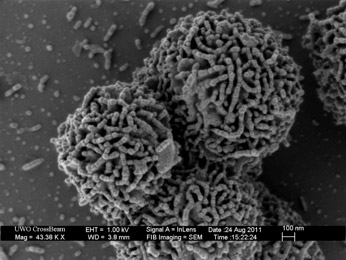Sub-zero bacteria from Canada’s north could indicate life on Mars
Bacteria found to survive at extreme cold temperatures are giving scientists the hope that they will find life in outer space, either on Mars, Jupiter’s moon Europa, or Saturn’s moon Enseladus.
Planococcus halocryophilus bacterium
On a research expedition to Ellesmere Island, McGill University Professor Lyle Whyte was not expecting to find bacteria that could survive at temperatures well below zero. But that is exactly what he found, pointing to a possibility that there is life beyond this planet just waiting to be discovered.
“I started working with NASA in 2003 on a project to develop a robotic drill that could eventually go to Mars to sample the subsurface. My role in this project was to search for microbes in the permafrost core samples and determine if they were alive or just frozen in time, like microbial woolly mammoths,” said Whyte. “It’s extremely hard to dig in permafrost, but from one of the core samples came the bacteria Planococcus halocryophilus… a champion of cold temperature survival.”

Whyte says that Planococcus bacteria can survive at temperatures at least as low as -25ºC, and can reproduce at -15ºC, the coldest temperature yet shown for a microorganism.
Whyte, along with a team that included Nadia Mykytczuk from Laurentian University, and John Lawrence of the National Hydrology Research Centre in Saskatoon, used the Canadian Light Source to study the bacteria. What they found was a very strange outer surface made of calcium carbonate.
“This is interesting because calcium carbonate starts to crystallize and has the potential to leave behind a remarkable fossil… potentially it would be well preserved for very long time, and potentially similar microbes on Mars, if they ever existed, would also form such fossils that could be detected in future missions to Mars.”
Whyte is a member of the European Space Agency Landing Site Selection Working Group for an upcoming mission, known as ExoMars, scheduled for launch in 2018. He hopes his help could lead to the discovery of life beyond the planet.
Recent missions, like NASA’s Mars Science Lander (MSL) Rover, have landed on the planet with a goal of characterizing the rocks and soil that hold clues to past water activity, but “the last mission to actually search for life in space was in 1976, when the Viking mission landed on Mars,” he says.
ExoMars plans to land a robotic vehicle on the Red Planet, complete with a drill system capable of taking samples two metres below the surface. If there is life on Mars, Whyte thinks bacteria, like Planococcus, could be exactly what they find. However, the search could be difficult.
In a simulation experiment, Whyte has tried to probe for life in Antarctica’s University Valley, an area almost void of life, and come up with nothing. But “the potential is there,” he says.
Mykytczuk, N. C. S., et al. "Microscopic characterization of the bacterial cell envelope of Planococcus halocryophilus Or1 during subzero growth at− 15° C." Polar Biology (2015): 1-12. DOI: 10.1007/s00300-015-1826-5
For more information, contact:
Victoria Schramm
Communications Coordinator
Canadian Light Source
306-657-3516
victoria.schramm@lightsource.ca
